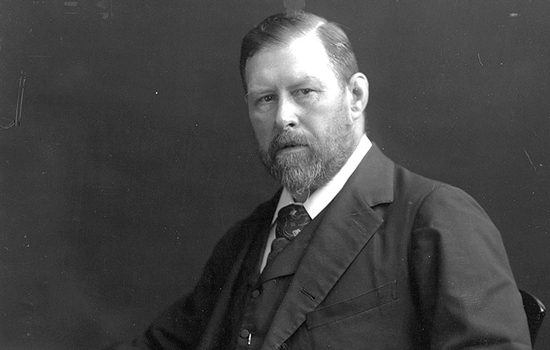A town made for gothic tales
Vampires – undead creatures who survive by feeding on the blood of the living – have a long history. Across centuries and cultures, blood has been seen as a powerful, symbolic and life-giving force, central to health.
No vampire is more iconic than the bloodthirsty Dracula, invented in 1897 by Irish novelist Abraham – or ‘Bram’ - Stoker (1847-1912). Stoker came to Whitby in the summer of 1890, and found its cliff-top abbey, churchyard and maritime folklore provided all the eerie atmosphere needed for his haunting tale. Visiting the local library, he discovered the name of a 15th-century prince, Vlad Dracula, said to mean ‘Devil’ in Wallachian (a dialect of Romanian). He noted this chilling detail on 8th August 1890, the date he would give to the arrival of the fictional ship Demeter in Whitby, carrying the ghastly Count onboard.
Yet, for all its fangs and folklore, Dracula is also a surprisingly modern story, where science and medicine are shown to be tools of hope when pitted against the evil Count. While Mary Shelley’s Frankenstein warned of science gone awry, Stoker’s Dracula embraces the latest innovations of the age: railways, phonographs, telegrams and, remarkably, for the first time in fiction, blood transfusion.
From blood takers to blood donors
Dracula’s first victim is 19-year-old Lucy Westenra. As her mysterious illness worsens, Professor Abraham Van Helsing, a polymath and doctor, is called in to help. He recognises immediately the puncture marks on her neck and the cause of her ghostly pallor:
“There is no time to be lost. She will die for sheer want of blood to keep the heart's action as it should be. There must be transfusion of blood at once”.
In a desperate effort to save her, Lucy receives four blood transfusions from four different men: Arthur Holmwood, Quincey Morris, Dr John Seward, and Van Helsing himself.
When Dracula was published, blood transfusion was a known but high-risk procedure, attempted only as a last resort. With three brothers trained in medicine, it is no surprise that Stoker was aware of the practice. As in the novel, transfusions at that time were performed person to person, as blood would clot within minutes of leaving the body. It wasn’t until 1914 that the first anticoagulants (sodium citrate) were used, making blood storage possible for the first time.
Infusing life
Stoker drew on the results of over two centuries of experimentation with blood transfusion. Inspired by William Harvey’s theory on the circulation of blood, in 1665, English doctor Richard Lower conducted a gruesome experiment, transfusing blood between two dogs using quills.
The next step was to try transfusing animal blood into humans. In 1667, a fever-sick 15-year-old was transfused with 12 ounces of lamb’s blood by Parisian physician Jean-Baptiste Denis, apparently curing him of his illness. That same year, Richard Lower performed the same experiment in front of the Royal Society on the ‘harmlessly insane’ divinity student Arthur Coga, who was paid to receive the animal’s blood through a procedure using quills and silver tubes. Lamb’s blood was chosen as it was thought to quieten the spirit of an agitated person.
Despite initial promising results, Denis’s and Lower’s subsequent experiments transfusing animal blood to humans resulted in deaths and controversy, and the practice was eventually banned.
150 years later, London obstetrician James Blundell (1790-1878) showed that human-to-human blood transfusions could be used to treat women bleeding to death after childbirth. In 1818, he attempted the first human blood transfusion, but it took another ten years (and five more failed attempts) before he recorded his first success - transfusing a 25-year-old woman after the birth of her third child. Afterwards, the woman was recorded as feeling as if “life was being infused into her whole body”.
Stoker doesn’t describe in detail how Lucy’s transfusions were carried out, but it would be easy to imagine Van Helsing arriving with a transfusion kit designed by Blundell. His methods included the direct transfer of blood by syringe and a cup and funnel system that relied on gravity to move blood from donor to recipient.
Not all blood is the same
Lucy survives four transfusions from four different donors before her fate is finally sealed by the Count. Given the risks posed by unmatched blood, this seems nearly miraculous. Nineteenth-century doctors like James Blundell, or Stoker’s contemporaries, couldn’t explain why some transfusions succeeded and others triggered severe if not fatal reactions.
In 1901, three years after the publication of Dracula, Austrian Physician Karl Landsteiner (1868-1943) made a remarkable discovery. He showed that human blood wasn’t all the same - but could be grouped according to how an individual’s blood reacted when mixed with others. He identified three of the four main blood types: A, B, and O – with the fourth group AB added the following year. Combinations of proteins and sugars, called antigens, on the surface of red blood cells are what make a blood type either compatible or not with others, explaining why some transfusions worked and others didn’t. This discovery won Landsteiner a Nobel Prize in 1930 and laid the foundation for safe blood transfusions.
Stoker didn’t know about blood groups – yet in Dracula, it is clear that not all blood is treated equally. However, the differences are more symbolic than medical. Lucy’s first donor, her fiancé Arthur, is described as having “blood so pure”. Van Helsing declares, "A brave man’s blood is the best thing on this earth when a woman is in trouble". For Stoker, youth, strength, and, above all, masculinity are sources of the best blood to ensure a successful transfusion. The idea of using Lucy’s maids’ blood is dismissed by Van Helsing outright, because of their gender and assumed weakness:
"We must have another transfusion of blood… I fear to trust those women, even if they would have courage to submit."
Transfusion is presented as a symbol of male heroism and sacrifice, where women are saved by the strength and vitality of men. This mirrors the medical practices of doctors such as James Blundell, who relied on transfusions from male colleagues and the husbands of his patients, believing men ‘bleed more freely and are less liable to faint’.
Today, over 50% of UK blood donors are women – proof that strength comes in many forms.
This Halloween, be your own Van Helsing
Every day, hospitals in England need around 5,000 blood donations to treat patients with injuries, blood disorders, cancers, and complications from childbirth. Thanks to generous donors, thousands of lives are saved and transformed each year.
This Halloween, English Heritage is joining forces with NHS Blood and Transplant to highlight the ongoing need for blood donors, and is offering visitors a chance to discover their own blood type.
On 31 October, you can pick up a free blood-type testing kit at selected English Heritage sites across the country, including at Whitby Abbey. Come and discover your blood group, learn about the science of donation, and find out how you can help save lives. Click or tap here for more information and a full list of participating sites.
Find out more about giving blood at https://www.blood.co.uk/
Find out more about giving bloodMore to explore
-

Plan a visit to Whitby Abbey
Haunting Gothic ruins high above picturesque Whitby
-

Dracula and a brief history of vampires
-

How Dracula came to Whitby
